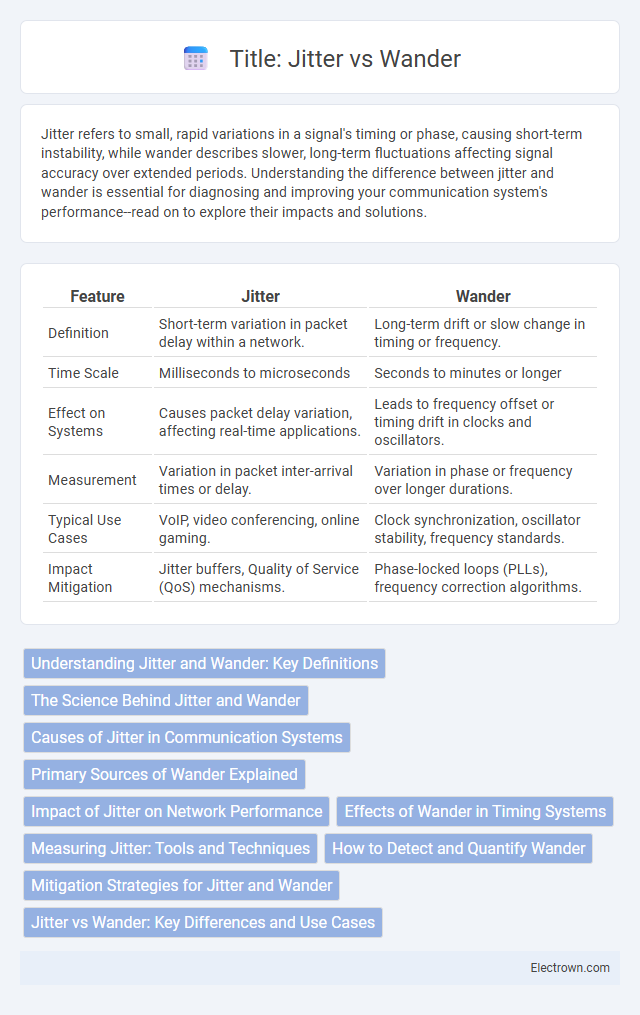Jitter refers to small, rapid variations in a signal's timing or phase, causing short-term instability, while wander describes slower, long-term fluctuations affecting signal accuracy over extended periods. Understanding the difference between jitter and wander is essential for diagnosing and improving your communication system's performance--read on to explore their impacts and solutions.
Table of Comparison
| Feature | Jitter | Wander |
|---|---|---|
| Definition | Short-term variation in packet delay within a network. | Long-term drift or slow change in timing or frequency. |
| Time Scale | Milliseconds to microseconds | Seconds to minutes or longer |
| Effect on Systems | Causes packet delay variation, affecting real-time applications. | Leads to frequency offset or timing drift in clocks and oscillators. |
| Measurement | Variation in packet inter-arrival times or delay. | Variation in phase or frequency over longer durations. |
| Typical Use Cases | VoIP, video conferencing, online gaming. | Clock synchronization, oscillator stability, frequency standards. |
| Impact Mitigation | Jitter buffers, Quality of Service (QoS) mechanisms. | Phase-locked loops (PLLs), frequency correction algorithms. |
Understanding Jitter and Wander: Key Definitions
Jitter refers to short-term variations in signal timing caused by rapid fluctuations, often measured in nanoseconds and impacting data transmission accuracy in high-speed networks. Wander describes longer-term timing variations occurring over seconds or minutes, influencing synchronization in telecommunications and precision systems. Understanding the distinct characteristics of jitter and wander helps you optimize network performance and maintain reliable time-sensitive communications.
The Science Behind Jitter and Wander
Jitter and wander are two critical phenomena in signal timing that impact communication and synchronization accuracy. Jitter refers to short-term variations in signal timing, typically measured within milliseconds, caused by rapid deviations such as phase noise or random fluctuations. Wander represents long-term timing variations over seconds to minutes, often resulting from environmental factors or oscillator instability, affecting the overall synchronization of networks.
Causes of Jitter in Communication Systems
Jitter in communication systems primarily originates from clock instability, network congestion, and signal interference, causing variations in packet arrival times. Electronic component imperfections and temperature fluctuations further contribute to timing inconsistencies, degrading data transmission quality. These causes lead to synchronization errors, affecting the overall performance and reliability of digital communication networks.
Primary Sources of Wander Explained
Primary sources of wander include slow variations in network delay due to equipment temperature fluctuations and frequency instabilities in timing devices, causing long-term phase shifts. Environmental factors such as temperature changes impact oscillators, leading to gradual time drift that affects synchronization accuracy. Understanding these sources helps you implement precise timing solutions to minimize wander in communication systems.
Impact of Jitter on Network Performance
Jitter causes packet delay variation, leading to inconsistent latency that disrupts real-time communications such as VoIP and video conferencing. High jitter results in packet loss and retransmissions, degrading overall network throughput and user experience. Network devices typically implement jitter buffers to mitigate its impact and maintain smooth data flow.
Effects of Wander in Timing Systems
Wander in timing systems causes low-frequency phase variations that disrupt synchronization accuracy, leading to data errors and signal degradation over time. Unlike jitter, which affects short-term stability, wander impacts long-term system performance by introducing timing offsets critical in telecommunications and network infrastructure. Your timing equipment must compensate for wander to maintain precise signal integrity and reliable communication.
Measuring Jitter: Tools and Techniques
Measuring jitter involves using precise tools such as oscilloscopes, phase noise analyzers, and Time Interval Analyzers (TIAs) to capture timing variations in signal edges or clock pulses. Techniques include statistical analysis of sampled data, eye diagram inspections, and spectral analysis to quantify jitter magnitude and frequency components. Your choice of method depends on the signal type and required resolution to ensure accurate identification and mitigation of jitter-induced errors.
How to Detect and Quantify Wander
Detecting and quantifying wander involves analyzing low-frequency phase variations in signal transmission over time using specialized equipment such as phase noise analyzers or time interval analyzers. Precise measurement techniques include tracking the phase deviation from the ideal clock frequency and calculating statistics like peak-to-peak wander and root mean square (RMS) wander. Your choice of detection method influences accuracy in characterizing wander's impact on network synchronization and overall signal integrity.
Mitigation Strategies for Jitter and Wander
Mitigation strategies for jitter include the use of phase-locked loops (PLLs), jitter buffers, and adaptive equalization techniques to stabilize signal timing and reduce high-frequency variations. Wander mitigation involves more precise clock synchronization methods such as synchronous Ethernet (SyncE), Precision Time Protocol (PTP), and network equipment with low phase noise oscillators to address long-term phase shifts. Both require robust monitoring tools and corrective algorithms to maintain signal integrity and ensure optimal network performance.
Jitter vs Wander: Key Differences and Use Cases
Jitter refers to the short-term variations in signal timing or phase, typically occurring over milliseconds, while wander denotes long-term slow variations spanning seconds to hours. Jitter is critical in high-speed digital communications where timing precision affects data integrity, whereas wander impacts synchronization in telecom networks and systems relying on stable frequency references. Understanding their distinct time scales and effects helps engineers design mitigation strategies tailored to maintain signal quality and network performance.
Jitter vs Wander Infographic

 electrown.com
electrown.com